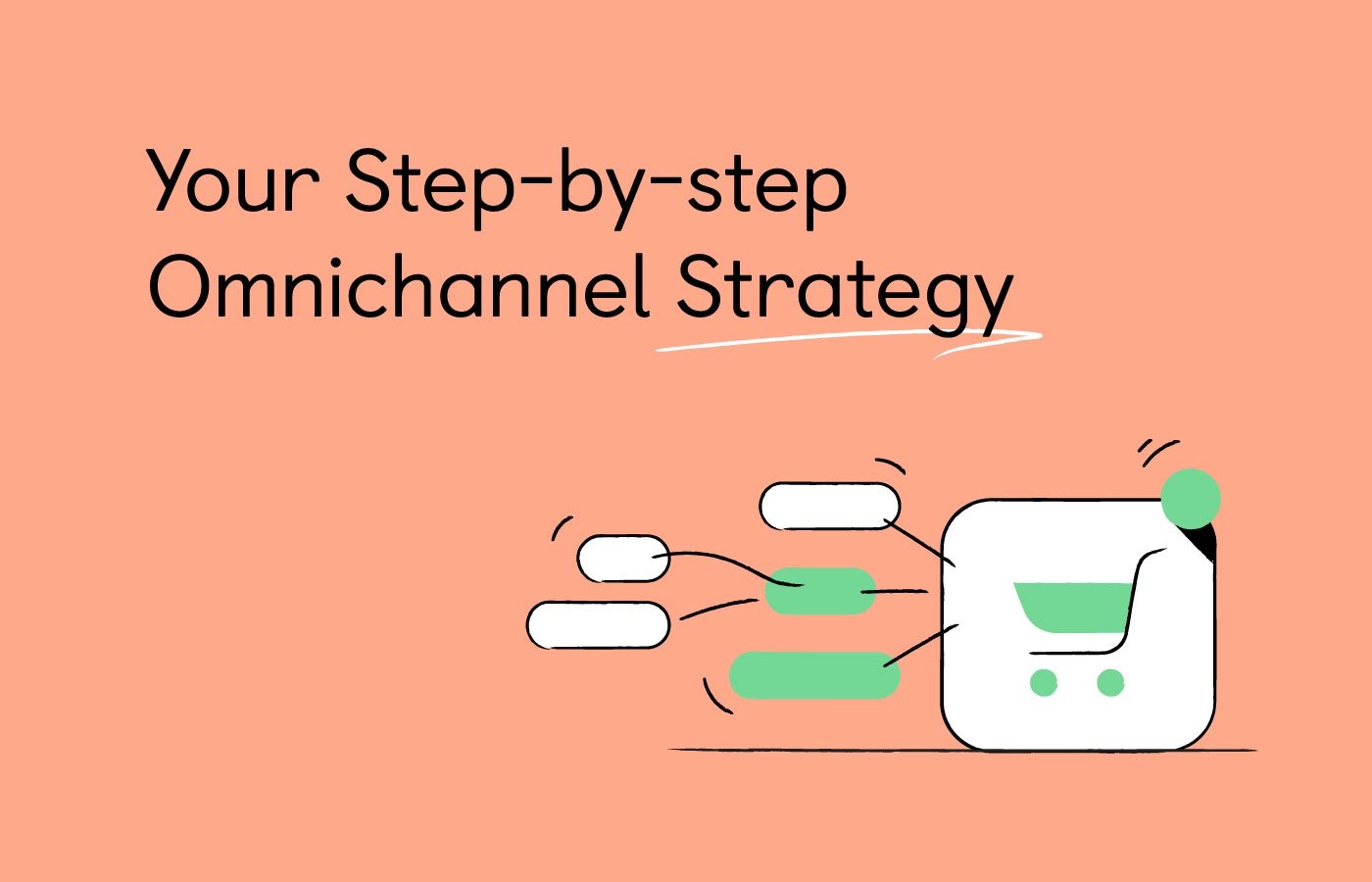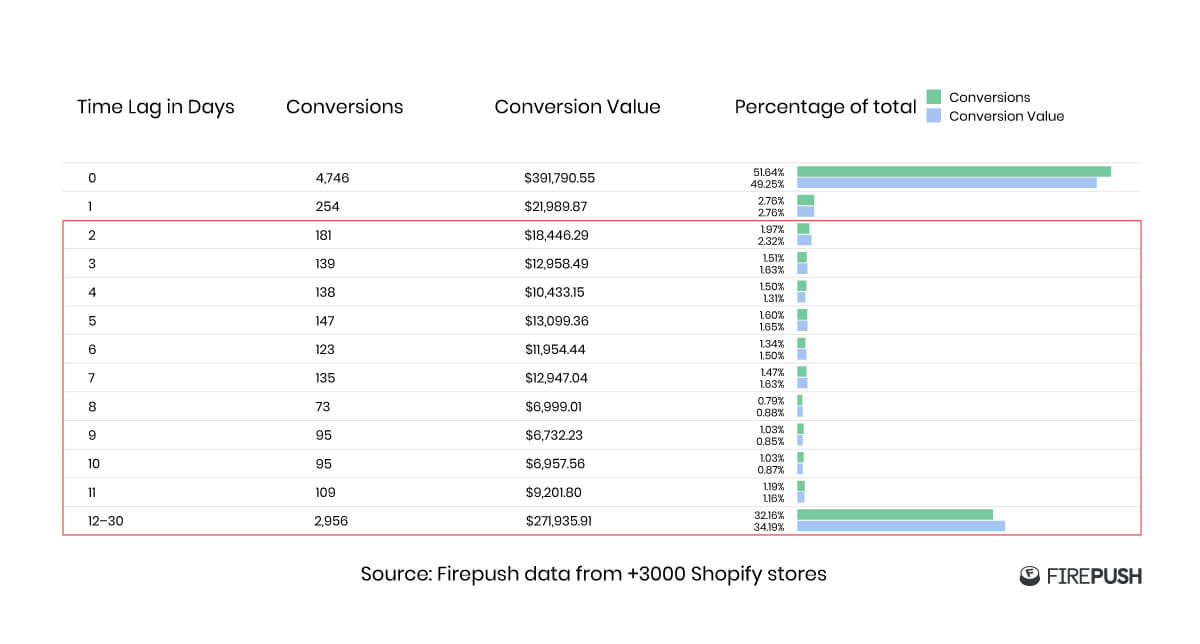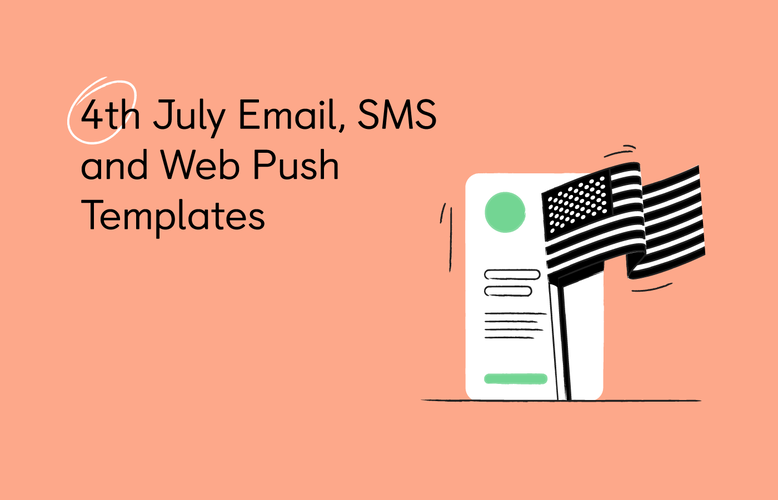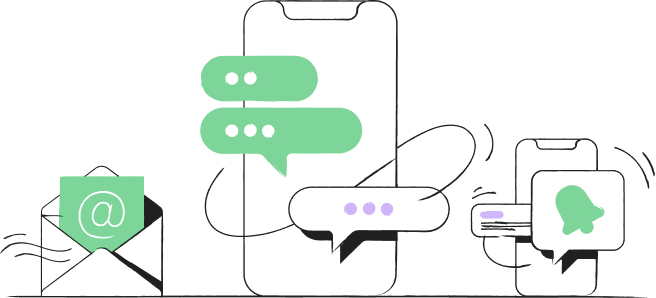
Navigation menu
What’s the single most expensive part of your ecommerce marketing?
The answer is simple - getting your product in front of people.
Whether it’s through SEO, inbound marketing, paid ads or something else, you’re going to end up spending the largest share of your marketing budget on getting traffic to your Shopify store.
But all this spend is worth nothing if this traffic doesn’t turn into sales.
One of the most effective ways to ensure more of your traffic converts into revenue is retargeting - sending follow up messages or ads to people who have visited your store, added an item to a cart, or even made a purchase.
And retargeting costs a fraction of what marketers spend on acquiring traffic and leads in the first place.
It’s surprising, then, that so many Shopify stores still only operate very basic retargeting strategies (in other words, generic email campaigns that are not omnichannel) or even none at all. This is like investing in an expensive car, then not paying for any gas.
This blog is all about the gas that will drive your sales and accelerate your growth with omnichannel retargeting strategy.
Firepush offers dedicated support and FREE consultations to find right strategy for you
Book my demoRetargeting importance for Shopify store
Take a look at this is data that Firepush has collected from thousands of Shopify stores, and it shows something really important:

This data tells us something really important - that there are a huge number of sales to be won after the first visit. Almost half of all sales take place at least one day after a customer visits a site. And a third of all sales happen after at least 12 days.
To put this another way, you can impact 50% of your sales through retargeting - sending emails, SMSs, or push notifications after a first visit to your site. That’s because 50% of your site visitors aren’t going to make a purchase straight away.
For Shopify stores that selling unique or highly expensive items, this is even more important, because customers will typically take longer over a high-value purchase.
A basic approach to retargeting
If we would think about typical sales funnel and explain it in favicon style for Shopify store it would look like this:

You drive traffic through facebook ads, customers land on your pages, and they add something to their cart. Some of them go on to complete the purchase, but many of them leave without doing so.
For this situation, most stores have default Shopify retargeting messaging by email set up. And usually, they just leave it at this and hope that everything will work out - the customer will open the email, the email will drive them back to the store, and they’ll complete the purchase.
But normally this isn’t what happens. Normally, most customers never see those emails, or if they do see them they don’t open them, and the sale is lost.
Not sure if omnichannel retargeting is for you? Get a FREE consultation to find out
Book my demoAn omnichannel solution for retargeting
Omnichannel retargeting is a smart approach to addressing the problem we just mentioned. So let’s take a detailed look at what it is, how it works, and why it’s so much more effective.
What is omnichannel?
Omnichannel means - using more than one channel for a marketing activity, and using these channels in a coordinated and integrated way.
You don’t need to look very far to find examples of omnichannel in use, in fact most merchants use omnichannels (or we can say omni sources) to drive traffic to their store – Facebook, Google, Youtube, Instagram and so on (we’ll talk a bit more about traffic sources later). This approach makes sense, because it would be very risky to only rely on one source of traffic. Check how "Intelligent Blends" used Firepush through omnichannel approach to earn $12.7 for every subscriber.
Well, the same applies to retargeting. Rely on only one channel for your retargeting and you risk missing many of your customers. So let’s take a look at how an omnichannel approach to retargeting works.
What does an omnichannel retargeting strategy look like?
As we have seen, when it comes to a typical sales funnel, most stores only have emails for retargeting their customers.
Omnichannel is a more advanced approach that combines different channels into one. So instead of spamming people on different channels with as many different messages as you can send, the different channels support each other.
.jpg)
In this example, 30 minutes after a cart is abandoned the store sends web pushes and emails to retarget the abandoned cart customer. These channels are much cheaper than SMS messages, so you pick up as many conversions as you can using these channels first. Then after 50 minutes, you send an SMS message that supports the web pushes or emails you’ve already sent.
It seems simple, but there’s a little bit of magic to it.
What happens if someone receives your abandoned cart email and makes a purchase? Will they then receive an SMS message on top? Not if you’re using an integrated omnichannel platform like Firepush.
Firepush’s system checks for information related to each customer - for example, whether that abandoned cart is already cleared or not - before sending a message. This means that if it is cleared, we’ll stop sending. This saves you money, and also means your customers don’t get sent irrelevant messages that might annoy them.
Why brands need omnichannel - a case study
“Pura Vida Bracelets speak to two different audiences - the teens and young adults who wear the product and the Moms who actually make the purchase. This means we need to use multiple marketing channels.”
Margaret Odisho, eCommerce Manager at Pura Vida Bracelets
Pura Vida Bracelets has earned over $1 million in additional revenue using Firepush. And an omnichannel approach that goes beyond simply email is critical for their success:
This quote shows that if brands only focus on emails or only on SMS messages, they might not get where they want to in terms of growth. Even big brands who are bringing in hundreds of thousands every month can still get stuck at the same level and find it hard to grow. Adding additional retargeting channels, as Pura Vida bracelets has, can be a great way to get traction, get traffic to their site and start growing their sales again.
We can see how important omnichannel retargeting can be for your Shopify store, so now let’s take a look at 4 steps to follow when building your omnichannel set up:
- Driving quality traffic
- Setting up abandoned carts
- Adding promotional messages
- Introducing other message types
Successful omnichannel retargeting step 1 - driving quality traffic
Before you start adding retargeting campaigns to your store, you need to be sure you are driving good quality traffic. Because your retargeting will only work if you are messaging people who are actually interested in your products.
Imagine that you drive random people to your store, and then have retargeting tools like Firepush set up. You are going to retarget these random people, so you will pay for Facebook ads and then pay again for retargeting via emails, SMS or Web push. And the result is very few sales.
So it’s crucial to do your homework and target the right audience. Focusing on a niche is a smart idea, and you can try setting up your ads, installing supportive apps like print on demand. How does this work? Let’s imagine your ecommerce store sells bodybuilding equipment and apparel. Here’s how a layered approach would work.
- You target people who follow Arnold Schwarzeneger because he’s a bodybuilder. But not everyone who is following him is going to be a bodybuilder.
- So you add another layer. You find another famous bodybuilder, then target people who like both Schwarzeneger and this other famous bodybuilder.
- And you can keep adding other layers to get a more and more niche audience.
You will get a lower volume of traffic, maybe 100,000 instead of 1,000,000, but you will be targeting a clear niche. And it’s very important to do that initially.
You also need to think about the best sources of traffic.
Take a look at this data, which was gathered by BigCommerce from over 60,000 ecommerce stores.
.jpg)
As you can see, Facebook unpaid generates an almost 2% conversion rate, and it has the most social traffic. So, rather than focusing too heavily on paid ads, look to build up content on your Facebook page that drives traffic to stores. Instagram unpaid is also a highly effective channel - it generates 1.17% conversions and accounts for 24% of social traffic.
And what this data shows most of all is that you have to use multiple sources to drive traffic to your store. And don’t forget to think carefully about where your specific audience is active and where you should build up your social proof - it might be on Facebook, but it might be Twitter or even Reddit.
Beyond social, you also need to think about which other sources of high-quality traffic there are.
%20(1).jpg)
This data collected by BigCommerce shows the conversion rates different channels can bring you. As you can see, email performs very well in terms of conversions, as does owned content and direct traffic. So creating your own high quality content is a smart move, and so is finding affiliates where you can publish guest content. And don’t neglect SEO and SEM, as they also perform well.
Paid ads from social media have the lowest conversion rates of any of the sources, so make sure you are not too reliant on them.
Now that you have high quality traffic flowing to your store, it’s time to set up your omnichannel retargeting. And the best place to begin is with abandoned cart messages.
Successful omnichannel retargeting step 2 - setting up abandoned cart messages
The very first thing to do once you have installed a tool like Firepush is to set up abandoned cart messages. The reason is that for promotional campaigns to be effective you will need to have a substantial subscriber base. Retargeting abandoned customer carts is something you can start doing from day one, and these messages offer high return on investment and average order values.
SMS conversion rates / Sales / ROI
.jpg)
Abandoned cart messages on different channels
There are some key points to understand about how abandoned cart messages work on different channels.
For example, the way customers are subscribed for abandoned cart messages, and even the point at which these messages are triggered, is different for push notifications compared to SMS and email.
For web push notifications customers don’t even need to go to the checkout page to trigger an abandoned cart message. As soon as that person subscribes to pushes on your store then your retargeting tool starts to track them. If that person adds something to their cart then leaves, the messages are triggered even if they did not proceed to checkout.
And with SMS messages, ensuring your store is TCPA compliant is a must. It’s not enough to leave one line on your checkout saying “I agree to receive promotional messages.”
The TCPA requires additional information - you have to explain clearly that they will start getting SMS messages from you, and show them how to subscribe, how to unsubscribe, and how to seek help if they need it.
Your retargeting provider should be set up to be TCPA compliant. For example, Firepush has very powerful tools implemented which provide guidance on how to make the right changes on your checkout page for SMS marketing. So before you send a single SMS message, go and set up those things first.
If you don’t, you can receive fines of up to $1,500 per message. So you could be running your business successfully, and do a small “cheat” like pre-selecting checkboxes on your check out page. You might think that it is worth it because you’ll get more subscribers that way. But at the same time you are going to get people who might not want to get your messages. Worse still, they are the ones most likely to sue you. Or at the very least they will simply ignore your messages which you keep sending and paying for with no chance of a sale.
With SMS marketing it’s very important to make the small changes required to be TCPA compliant, and to ensure you use a retargeting app that is as well.
Timing your abandoned cart messages on different channels
Once you have organised your channels and got everything set up, you’ll need to think about timing. Abandoned cart messages are sent in a flow or usually 2 or 3, each at different intervals from one another. And the timing of these messages has a big impact on how effective they are.
Firepush has conducted research from 3,000 Shopify stores based on SMS messages and other message types regarding the best timings to send abandoned cart messages.
.jpg)
Messages sent 30 minutes and 50 minutes after the cart was abandoned generate the highest return on investment (ROI). In other words, these are the times that are likely to bring you the best return for your spend on retargeting.
So a smart strategy is to set your emails and web pushes to send at 30 minutes. Then if they don’t buy after these messages, you send an SMS message on top.
Get omnichannel abandoned carts and other retargeting with Firepush
START NOWSuccessful omnichannel retargeting step 3 - promotional messages
With your abandoned cart messages set up and your subscriber base growing, the next step is to start with promotional messages.
You’ll see from the table below that, although the conversion rates and ROI for promotional campaigns are lower, they account for 67% of total sales, by far the biggest for any message type.
(1).jpg)
How do we explain this? The answer is simple - abandoned cart messages will only be sent to a small proportion of your subscribers. Meanwhile, welcome and win-back messages will only be sent once, thus limiting their overall impact.
This means promotional messages are the best way to keep your omnichannel retargeting success growing.
One of the key questions to address regarding promotional messages is whether to include a discount with these messages or not, and if so how big should the discount be.
Should you include a discount?
The answer to this question is a bit surprising. Firepush has conducted research based on millions of messages sent. As you can see from the table below, the conversion rates ar very similar for messages sent with a discount and messages sent without one.
.jpg)
What’s more, the click rates are actually higher for promo campaigns without a discount code. Plus the average order value will be much higher without a discount code, so you have to be very careful.
This doesn’t mean that discount codes don’t work – they definitely do. But you need to know what you’re doing.
How to use discounts effectively
Coming up with the right discount, and presenting it in the right way in your retargeting messages, takes careful consideration.
One key factor to think about is the size of the discount. Have a look at the SMS examples below.
.jpg)
These are taken from real SMS campaigns by the same store, each sent to over 50,000 subscribers.
They show that if you have a really really good deal, then SMS messages, or any messages in fact, will work really well. In this example we can see that the message offering a 30% discount secured 450 orders, compared to 291 for the campaign offering a 20% discount code.
Creating curiosity in discount text is also key. The best performing message doesn’t display exactly how big the discount is. Instead, it uses bold copy to create curiosity - subscribers want to click to discover what is included in the “Biggest ever warehouse clearance.”
Scarcity is also important
Let’s say you arrive on a website which has pop-ups on every move with offers to get a discount code, and there’s a discount for email subscription and one for phone subscription as well. And then you receive a promotional message with a similar discount. You will just think “I can get that discount code anytime, anyway. So what’s the point in going now and buying?”
A better strategy is to not give discount codes very easily or too often. Then, when you offer even a 20% discount code, it could have a huge impact.
Point to consider is urgency - All of these messages emphasise that time is limited:
- “NOW!”
- “FINAL HOURS!”
- “Hurry”
Combining strong discounts with high urgency is very effective. Here’s a strategy Firepush omnichannel retargeting app often uses:
Combine a high value discount code (let’s say 25%) with an offer to subscribe, but limit the discount code validity to 20 minutes. You will get lots of subscribers, and many of them will go on to make a purchase straight away.
Successful omnichannel retargeting step 4 - additional message types
Let’s take one more look at the data on ROI for different message types.
(1).jpg)
When it comes to the long run, in terms of ROI abandoned cart messages are highly effective, whether sent by email, SMS, or push notifications. As we have mentioned already, this should be your first step because abandoned cart messages have conversion rates of more than 2% and generate about 29% of all sales, with an average cart of $62.
Then your main sales driver, even though it has a much smaller conversion rate of 0.53%, is going to be promo messages. Just remember with these message types no to over send. If you start sending messages every day then people will start ignoring them and then they unsubscribe, but basically these numbers show where you should focus.
Then it is worth considering other automated message types, such as Win Back messages and messages to reward new customers.
Win Back messages are sent automatically to customers who either made a purchase or visited your site a while ago, but haven’t been interacting with you recently. These are often sent with a discount, and have strong conversion rates.
And an interesting point from the data is that Reward New Customer SMS messages work really well. These messages are only sent once, when a new customer subscribes, which is why they only generate a few percent of total sales. But the ROI is almost 40%, which means they are highly effective. So if you offer a decent sized discount code to your new subscribers, you will potentially get a sale.
Taking your retargeting further
With all of your message types set up across multiple channels, your retargeting should be highly effective at growing your sales and improving conversion.
From here, it makes sense to consider other types of retargeting. Consider once more the data on when sales are made.
.jpg)
Tools like Firepush are excellent for retargeting and covering days 0 through 3 or 4. But it’s not possible to send SMSs or push notifications to your customers every day for 20 or 30 days. So that’s why you should turn on Facebook retargeting ads, for example. This will help you to get you a much better return on investment on your ad spend and on your marketing efforts. And it will mop up those last remaining sales.
With Facebook ads you need to show yourself up to 10 times to your customers. Otherwise it’s difficult for them to remember you. If they checked out your website a while back it may be difficult for them to remember the domain name. So if you start retargeting them on Facebook it will be easier for people to come back and buy.
Key takeaway: omnichannel is key
As you can see, there’s lots to consider when it comes to retargeting. And hopefully this blog has given you a pretty clear picture of how to get set up and then gradually optimise.
One thing that is important to understand is that just because you have a basic retargeting setup worked out for your store (like email) it doesn’t mean it’s going to be effective. You may be sending messages to a channel where most of your customers don’t hang out.
For retargeting to be effective, you want to be on as many channels as possible to give yourself the best chance of engaging with your customers.
Get Omnichannel for your store today with Firepush
Install now











